Solidago, commonly known as Goldenrod, is emerging as a distinguished choice for wedding floral arrangements due to its vibrant yellow hue and enduring vase life of 7-10 days. This flower, native to North America and extensively cultivated in Ecuador, not only adds volume and dimension to bouquets but also harmonizes with diverse color palettes and themes. Its year-round availability and cost-efficiency make it an attractive option for couples planning their special day. To understand the full potential and versatility of Solidago, one must explore its physical characteristics, cultural significance, and best growing conditions.
Flower Overview
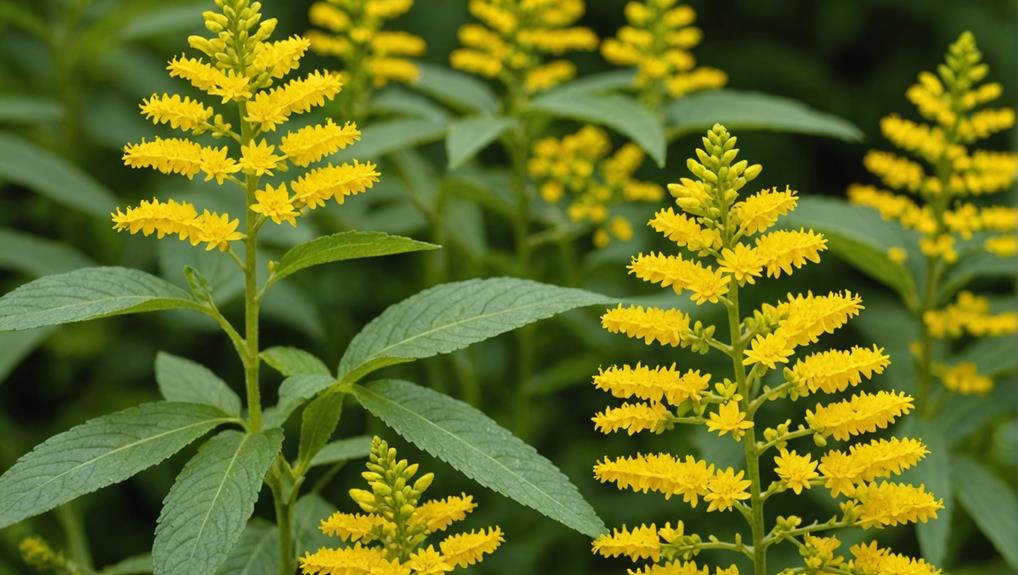
Solidago, often referred to as Goldenrod, is a vibrant yellow flower admired for its striking color and unique shape in floral arrangements. Yellow Solidago is indigenous to North America and has gained a reputation for bringing good fortune, even being recognized as the state flower of Kentucky. Its sunny, cheerful tone makes it a popular option for weddings and other festive occasions, where it brings a hint of radiance to any environment.
One of the notable aspects of Yellow Solidago is its impressive longevity in vases. When properly tended to, Solidago can stay fresh for 7 to 10 days, making it a superb selection for bouquets and centerpieces that need to preserve their beauty for an extended period. Its year-round availability further boosts its appeal, providing flexibility for various occasions regardless of the time of year.
Solidago's stems typically measure between 60-80cm in length, allowing for versatility in arranging them with other flowers. It pairs exceptionally well with sunflowers and daisy poms, adding volume and vibrancy to floral arrangements. This flexibility guarantees that Yellow Solidago remains a fundamental component in the floral industry, valued for both its visual characteristics and practical advantages.
Physical Description
With its glowing yellow shade and unique form, Goldenrod stands out as a captivating element in any floral arrangement. This lively flower, known scientifically as Solidago, is celebrated for its ability to add volume and dimension to bouquets and centerpieces, making it an essential choice for weddings and other significant events.
Solidago stems typically reach a length of about 28 inches (70 cm), providing ample height for various floral designs. Available throughout the year, these flowers ensure consistency and dependability for any occasion. When properly cared for, Solidago boasts an impressive vase life of 7 to 10 days, offering lasting beauty.
The physical characteristics of Solidago make it an excellent option for those seeking flower substitutions that enhance the overall visual impact of an arrangement. Key attributes include:
- Lively Color: The vivid yellow shade evokes feelings of warmth and joy.
- Textural Appeal: Its unique form adds intricate texture, making arrangements more dynamic.
- Versatile Pairing: Solidago pairs harmoniously with sunflowers and daisy poms, creating cheerful and cohesive displays.
Grown in Ecuador, Solidago is a tribute to nature's ability to bring vibrancy and versatility to floral artistry.
Available Colour Varieties
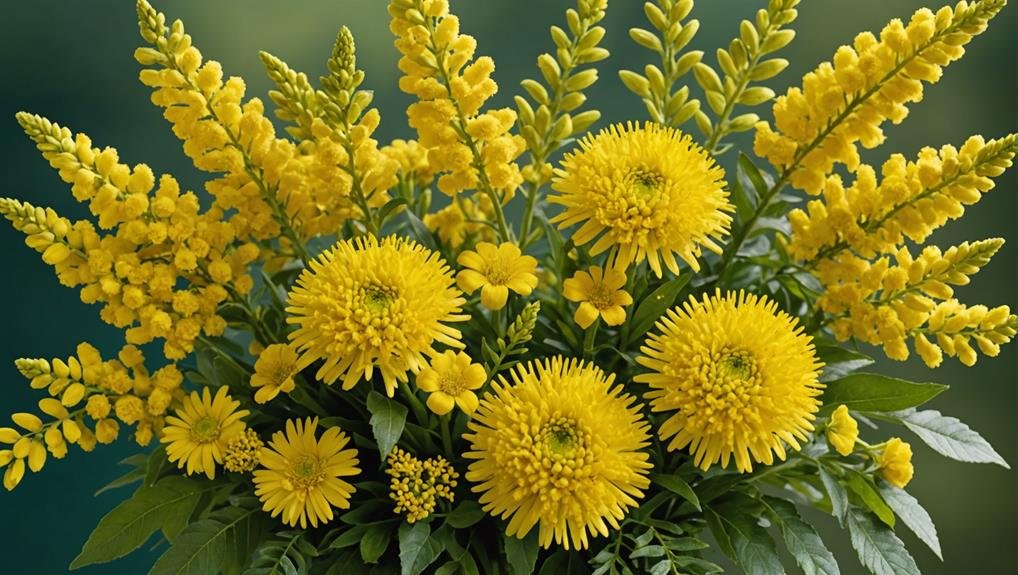
Frequently admired for its vibrant golden yellow hue, Solidago also offers a range of colors that can enhance diverse wedding palettes. While the predominant color is bright golden yellow, Solidago flowers are available in various shades of yellow, from pale to vibrant hues. These subtle variations allow the flowers to blend seamlessly with different wedding themes, adding both color and volume to floral arrangements.
In addition to the classic yellow, some Solidago varieties may exhibit hints of green or red in their blooms. These slight deviations in color can provide a unique twist to traditional floral designs, making them suitable for both rustic and elegant wedding settings. The similar color tones within the yellow spectrum guarantee that Solidago flowers can complement a broad array of other flowers and greenery, making them a versatile choice for any bridal bouquet or centerpiece.
The different color varieties of Solidago contribute to their popularity in wedding floral arrangements. By providing a spectrum of hues, these flowers can be customized to match or accentuate any wedding color scheme, from soft pastels to bold, vibrant themes.
Latin Name and Taxonomy
The botanical categorization of Solidago places it within the Asteraceae family, formally recognized by the Latin name Solidago spp. This genus encompasses a diverse array of species commonly known as goldenrod. Solidago spp. are renowned for their vibrant golden-yellow blossoms, making them a popular choice for wedding floral arrangements. Their classification within the Asteraceae family highlights their close relationship to other well-known flowers, such as daisies and sunflowers.
Solidago spp. are distinguished by several key characteristics that make them a unique addition to any floral design:
- Vivid Golden-Yellow Color: Their striking hue adds a touch of warmth and cheerfulness to bouquets and centerpieces.
- Abundance and Texture: Their plentiful blooms and feathery texture enhance the fullness and intricacy of floral arrangements.
- Seasonal Availability: Particularly plentiful in autumn and winter, Solidago spp. are perfect for cooler season weddings.
When choosing Solidago for your wedding, it is vital to select bunches with half-open yellow flowers and healthy green stems and leaves. This guarantees the freshest and highest quality blooms, enhancing the overall aesthetic of your special day. Solidago spp. not only provide visual appeal but also contribute to the symbolic richness of your wedding florals.
Geographical Origins
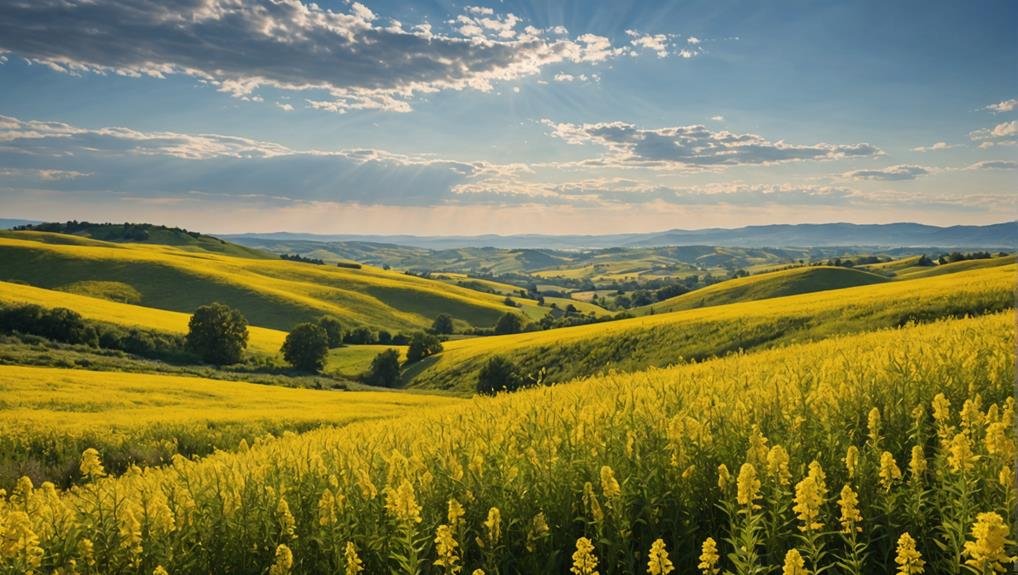
Solidago, commonly known as goldenrod, originates primarily from North America, with additional species found in South America and Europe. This flowering plant, renowned for its bright yellow blooms and robust nature, thrives in various climates and terrains across these regions. The vast majority of Solidago species are native to the United States and Canada, where they flourish in open fields, meadows, and along roadsides.
In South America, Solidago species are less prevalent but still contribute to the rich biodiversity of the continent. Meanwhile, Europe is home to a smaller number of Solidago species, which have adapted to the local climates and habitats. The plant's ability to thrive in diverse environments has facilitated its spread to other parts of the world.
In Australia, Solidago is widely cultivated and has become a common addition to floral arrangements, particularly during the cooler autumn and winter months. Some varieties are even imported to enhance the diversity of available blooms. The plant's versatility and vibrant color make it a favored choice for adding volume and depth to bouquets and other floral designs.
When selecting Solidago, it's advisable to choose bunches with half-open yellow flowers, ensuring healthy green stems and leaves.
Season Availability
In Australia, Solidago is mainly available during the autumn and winter seasons. This flower, also known as Goldenrod, thrives in the cooler months, making it a popular choice for weddings and events during this period. Its vibrant yellow blossoms add warmth and brightness to floral arrangements, providing a stunning contrast to the often subdued tones of autumn and winter.
For those planning a wedding during these seasons, Solidago offers numerous advantages:
- Availability: Solidago is readily available during autumn and winter, ensuring fresh and high-quality blooms.
- Durability: With proper care, the vase life of Solidago can extend to about 5 to 7 days, making it a reliable option for events.
- Versatility: This flower complements a variety of floral designs, from rustic bouquets to elegant centerpieces.
Commercially grown in Australia, Solidago is often locally sourced, though some varieties may be imported to enhance diversity. When purchasing Solidago, it is essential to look for bunches with half-open yellow flowers and healthy green stems to guarantee excellent freshness and longevity.
Growing Conditions
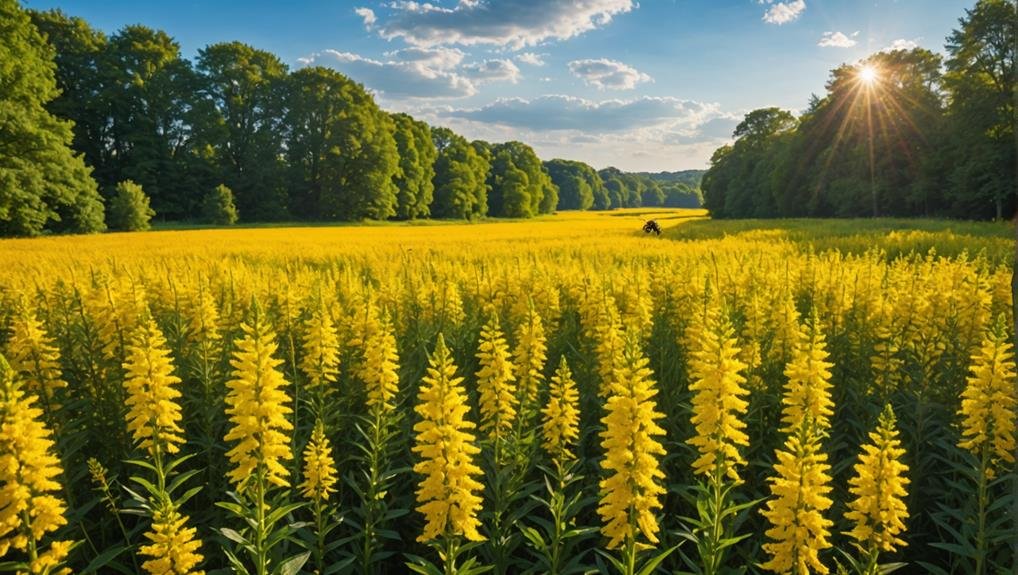
Thriving in full sunlight to partial shade, Solidago requires well-drained soil to flourish effectively. These resilient plants are also drought-resistant once established, making them an excellent choice for low-maintenance gardens. Solidago, commonly known as Goldenrod, is native to North America and attracts a variety of pollinators, including bees and butterflies. They bloom from late summer to early fall, introducing vibrant hues into garden landscapes. These plants can reach heights of 3-4 feet, making them a striking addition to flower beds or wildflower gardens.
To ensure optimal growth, it is essential to plant Solidago in conditions that mimic their natural habitat. Below is a table summarizing the key growing conditions for Solidago:
| Growing Condition | Requirement |
|---|---|
| Sunlight | Full sun to partial shade |
| Soil Type | Well-drained |
| Watering | Drought-resistant once established |
| Bloom Period | Late summer to early fall |
Solidago's robust nature not only makes them easy to grow but also extends their vase life: with proper care, they can last several days when cut for floral arrangements. By adhering to these growing guidelines, gardeners can enjoy the long-lasting beauty and ecological benefits of Solidago in their outdoor spaces.
Cultural Significance
Goldenrod holds a notable place in cultural history, serving not only as a symbol of resilience and beauty but also as a once-explored source for rubber production. The state flower of Kentucky, Solidago, or Goldenrod, captures significant cultural significance in various aspects.
In the early 20th century, Thomas Edison experimented with solidago for rubber production, showcasing its potential in industrial applications. This endeavor led to Goldenrod being used in the tires of the iconic Model T Ford, symbolizing innovation and adaptability.
Despite its promising start, the quest for solidago-derived rubber was abandoned following the advent of synthetic rubber. However, this period of experimentation underscores the flower's historical importance.
Beyond its industrial associations, Goldenrod continues to hold cultural significance through its vibrant presence in floral arrangements and its symbolic meanings.
To fully appreciate the cultural significance of Goldenrod, consider the following:
- Historical Experimentation: Showcased in early 20th-century rubber production efforts.
- State Representation: Officially recognized as the state flower of Kentucky.
- Symbolism: Represents resilience and adaptability, traits that resonate across cultures.
Goldenrod's rich history and cultural relevance continue to make it a beloved choice in various settings, reflecting both its aesthetic and symbolic value.
Typical Use in Weddings
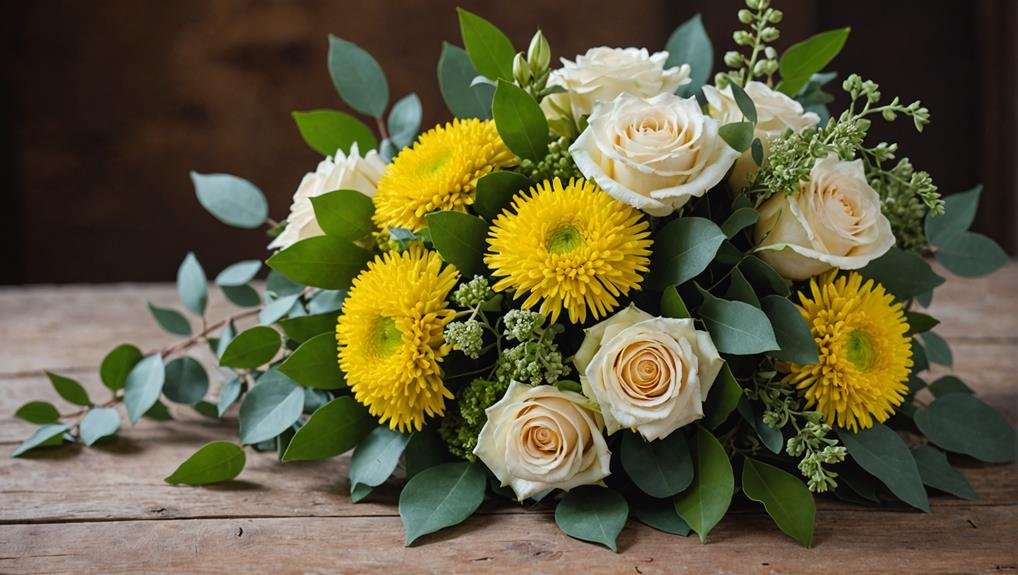
To sum up, Solidago is a popular choice in weddings because of its vibrant yellow color and ability to provide texture and fullness to floral arrangements. Its vivid and happy hue makes it a great addition to bouquets, centerpieces, and various other wedding flower decorations. Solidago's capacity to blend well with flowers like sunflowers, daisy poms, and other wildflowers further boosts its appeal, contributing to a rustic and joyful aesthetic that many couples seek for their special day.
An important benefit of using solidago in wedding arrangements is its extended vase life, lasting from 7 to 10 days with proper maintenance. This longevity makes solidago a cost-efficient option, ensuring that floral arrangements stay fresh and lively throughout the wedding celebrations. Whether integrated into small, intimate bouquets or elaborate, grand designs, solidago's flexibility enables it to elevate the overall appearance and atmosphere of any wedding floral exhibit.
Moxie has the authority to explore distinctive and innovative ways of utilizing solidago, guaranteeing that each wedding theme stands out and remains memorable.
To conclude, Solidago's vibrant color, texture, and enduring freshness make it a valuable addition to wedding floral arrangements.
Alternative Flower Types
While Solidago offers numerous benefits for wedding floral arrangements, exploring alternative flower types can provide additional options for achieving the desired aesthetic and thematic elements.
Solidago is often chosen for its bright yellow color and unique shape, but when considering alternatives, several options stand out.
- Sunflowers: Known for their bold and cheerful appearance, sunflowers can be an excellent choice for rustic or summer-themed weddings. They offer a vibrant and welcoming atmosphere, similar to Solidago, but with a larger and more dramatic bloom.
- Daisy Poms: These flowers are ideal for adding a simple yet charming touch to any arrangement. Daisy poms provide a classic look that complements a variety of wedding themes, from vintage to modern.
- Goldenrod: Often confused with Solidago, goldenrod is another bright yellow flower that can serve as a last resort if Solidago is unavailable. It shares similar characteristics and can be integrated seamlessly into floral designs.
Each of these alternatives can be mixed with other flowers to create a dynamic and visually appealing bouquet or centerpiece. While Solidago remains a versatile and durable choice, considering these alternatives can help tailor the floral arrangements to the specific vision of the wedding.
